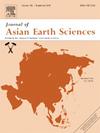华北克拉通带状含铁高品位磁铁矿形成的成矿流体:来自黄铁矿微量元素和硫同位素的约束
IF 2.7
3区 地球科学
Q2 GEOSCIENCES, MULTIDISCIPLINARY
引用次数: 0
摘要
带状含铁构造的高品位铁矿床是全球最重要的铁资源之一。高品位磁铁矿是另一种重要的磁铁矿类型,虽然没有赤铁矿常见,但主要产于华北克拉通北部。这些矿石通常被认为是由高温热液流体与~ 2.55 Ga BIF原矿相互作用形成的,但成矿流体的性质和来源仍不确定。根据其规模和蚀变特征,将高品位磁铁矿矿床划分为弓长岭型和齐大山型。对bif、高品位磁铁矿和高品位矿体周围蚀变岩中的黄铁矿进行了原位微量元素和硫同位素分析。在高品位磁铁矿矿床中,硫同位素可能受到多种因素的影响,因此在限制成矿流体来源方面效果较差,而黄铁矿的微量元素分析可以更精确地了解流体性质和来源。两个矿床的成矿流体均表现出与深部岩浆活动有关的热液系统特征。弓长岭矿床成矿流体主要来源于~ 1.85 Ga的岩浆活动,并有流体浸出古元古代富钴镍地质体的贡献。齐大山矿床以富砷硒流体为主,这些流体起源于~ 2.5 Ga左右的岩浆热液活动。我们认为深部岩浆活动是形成高品位铁矿床的基础,而像弓长岭这样的大型矿床的发育需要多期热液活动,其中包括富钴镍成矿流体。本文章由计算机程序翻译,如有差异,请以英文原文为准。
Ore-forming fluid for the formation of banded iron formation-hosted high-grade magnetite ores of the North China Craton: Constraints from pyrite trace elements and sulfur isotopes
Banded iron formation-hosted high-grade iron ore deposits are among the most important global sources of iron. Although less common than hematite ores, high-grade magnetite ores represent another significant type, occurring mainly in northern North China Craton. These ores are generally considered to have formed through the interaction of high-temperature hydrothermal fluids with ∼2.55 Ga BIF protore, yet the nature and origin of ore-forming fluids remain uncertain. Two types of high-grade magnetite deposits have been classified based on their size and alteration features: the Gongchangling type and Qidashan type. In situ trace-element and sulfur isotopic analyses were conducted on pyrite from BIFs, high-grade magnetite ores, and altered rocks surrounding high-grade orebodies. In high-grade magnetite deposits, sulfur isotopes may be influenced by multiple factors, making them less effective in constraining the source of ore-forming fluids, whereas trace element analysis of pyrite could provide more precise insights into fluid nature and source. The ore-forming fluids in both deposits exhibit characteristics of hydrothermal systems associated with deep-seated magmatic activity. In the Gongchangling deposit, the ore-forming fluids were primarily derived from magmatic activity at ∼1.85 Ga, with additional contributions from fluids leaching Paleoproterozoic Co-Ni-rich geological bodies. In contrast, the Qidashan deposit is dominated by As-Se-rich fluids originating from magmatic-hydrothermal activity around ∼2.5 Ga. We propose that deep-seated magmatic activity is fundamental for forming high-grade iron deposits, whereas the development of large-scale deposits, such as the Gongchangling deposit, requires multi-phase hydrothermal activity involving Co-Ni-rich ore-forming fluids.
求助全文
通过发布文献求助,成功后即可免费获取论文全文。
去求助
来源期刊

Journal of Asian Earth Sciences
地学-地球科学综合
CiteScore
5.90
自引率
10.00%
发文量
324
审稿时长
71 days
期刊介绍:
Journal of Asian Earth Sciences has an open access mirror journal Journal of Asian Earth Sciences: X, sharing the same aims and scope, editorial team, submission system and rigorous peer review.
The Journal of Asian Earth Sciences is an international interdisciplinary journal devoted to all aspects of research related to the solid Earth Sciences of Asia. The Journal publishes high quality, peer-reviewed scientific papers on the regional geology, tectonics, geochemistry and geophysics of Asia. It will be devoted primarily to research papers but short communications relating to new developments of broad interest, reviews and book reviews will also be included. Papers must have international appeal and should present work of more than local significance.
The scope includes deep processes of the Asian continent and its adjacent oceans; seismology and earthquakes; orogeny, magmatism, metamorphism and volcanism; growth, deformation and destruction of the Asian crust; crust-mantle interaction; evolution of life (early life, biostratigraphy, biogeography and mass-extinction); fluids, fluxes and reservoirs of mineral and energy resources; surface processes (weathering, erosion, transport and deposition of sediments) and resulting geomorphology; and the response of the Earth to global climate change as viewed within the Asian continent and surrounding oceans.
 求助内容:
求助内容: 应助结果提醒方式:
应助结果提醒方式:


